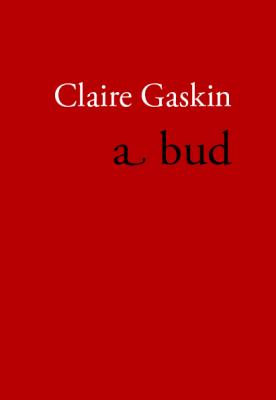 A Bud by Claire Gaskin
A Bud by Claire Gaskin
John Leonard Press, 2006
There is no firm ground in Claire Gaskin's new collection, A Bud. If you're looking for poetry that announces itself as a place to have your psychic tremors explained, your yearning reflected or your misappropriations mended, look elsewhere. Gaskin's poetry is itself raw psyche, yearning direct to the page without apology, and a paean to the misappropriations we make of our lives, thoughts, lovers and literature.
I had a great temptation to review Gaskin's collection through the grid of critical theory; to approach it as a critic, looking for holes or literary connections, rather than encountering it as a poet, appreciating the holes she in fact cuts into theory and experience via her poetry. In discussing A Bud, I've decided to offer my impressions from the latter perspective, giving myself permission to write about Gaskin's work from the aftershocks of engaging with her arrangement of collapsing images, lines and clauses that fall off into nowhere, leaving you still somewhere, squabbling with yourself about the view back up the cliff from where you've been thrown.
Open A Bud at any point and you'll find not only a poem, but also poems within poems. In 'Evening invites with bridges and verandahs', for example:
Throw the anchor down into the sea of his snoring
Flower above the bed in deranged colours
Many of the lines in A Bud's poems could have been boiled down to one-line poems, not dissimilar to the approach taken recently by Ian McBryde. Gaskin's one-liners, however, do not point to menace as much as become a kind of menace; a threatening of the reader's perceived safety in language and perception. And not only do entire poems resist closure, many of her lines resist closure in and of themselves, spin on their heels and click away. Her individual words get caught up in the performance, and resist and deflect meaning. This is surrealism, yes, fried and toasted with language poetry, but with a surety of effect, as can be seen in the poem 'There is a word':
I look for the coloured flag of silk
to mark where my child will be.
This is poetry that is, largely, best described by what it isn't: simple, narrative-based, imbued with images that eventually lay claim to rationality. Gaskin's gift is to fog up the window of perception then move her hand to rub it, offering with a glint in her eye to clear your view, but then finally allowing her hand to fall. Look, mum, no words – or at least not words as you know them – but poetry all the same, appears to be the silent catch cry here.
Australian precedents? John Forbes, Gig Ryan, Michael Farrell, John Kinsella – when the latter's poetry lilts across the urban. These voices are the echoes and, in Farrell's case, linguistic soundings, out of which Gaskin's voice emerges: clear, honed, rich – and defiantly her own. In 'Each other', for example:
No anxiety has family
A grey wall of brick cloud
and I didn't need to take violence personally
the sun fell, the dam blushed
You don't read A Bud, you journey into it. Gaskin's images do more than arrest – they sometimes present the evidence and then carry through with the court hearing. They often appear ready to settle into a predictable pattern that might offer up, at the end of a poem, an emotional culmination, but usually we are left with our fingers just out of reach of the stars, realising, of course, that they are reflections caught in a glass, darkly, somewhere. The poem, 'We sit on a bench poems blowing', makes reference to this effect:
moving away in and out of focus, not taking anything to its conclusion
The book presents as a series of interrogations of the world, relationships, selfhood, meaning and language. Once you turn off your expectations and tune into Gaskin's poetic demands, the ride is largely irresistible. There came a point, however, about two-thirds of the way into the volume, where I felt the poet was deliberately resisting applying imagery for more than effect, that certain 'collapsible' images would have been better held up on stilts and allowed to carry through to an erudite conclusion of her poetic disemboguement. There came a point in the book when this reviewer would rather not have encountered another 'leftover of birth' or section of 'aching water'. It appeared that the poet could do her imagist sleight-of-hand, her magician's trick, standing on her magician's hat, albeit outstandingly.
This continual assault of startling and almost impregnable images – 'Then she leaves like water/breaking its container'; 'The rain soaks into the ways of the wise . . .'; 'The leaf falls a boat and all I can hear is falling' – began to beg the question of whether the poet was allowing, in her image construction, little more than random builders, thrown off the street and into overalls, on site. Instead of, as I had been, enjoying the roller coaster-cum-ghost train ride, I stopped squealing with delight at each dip, and began to think about that moment when innovation becomes a trick rather than a treat.
This criticism, however, is one to which Gaskin is accustomed. And even when you might find yourself querying whether any image could have been added to the one before, you know you are reading a poet who recognises, as Kevin Hart wrote in an article on Tomas Tranströmer in Cordite (1998): ' . . .the important thing is not the poet's consciousness but what could be called the 'consciousness of the poem': a work's ability to signify in the absence of its maker.' Claire Gaskin's poetry comes loose of its maker and forces the reader to associate with it, on its terms. And these terms are well worth accepting.









